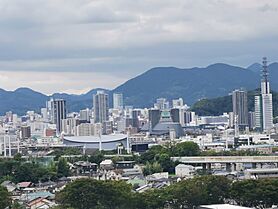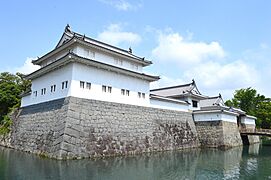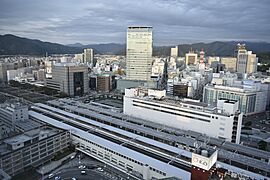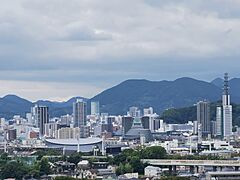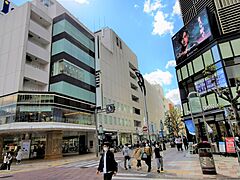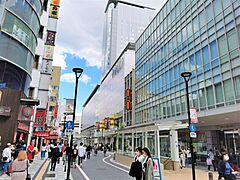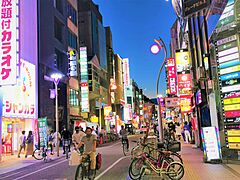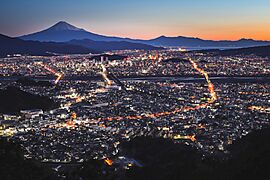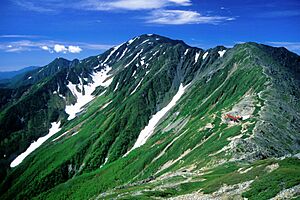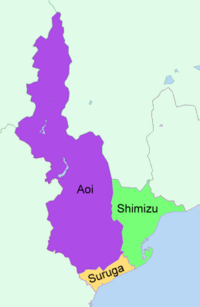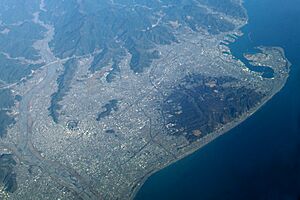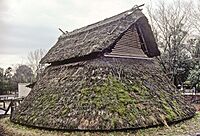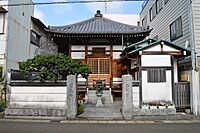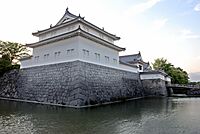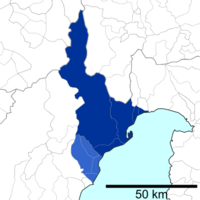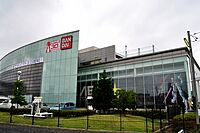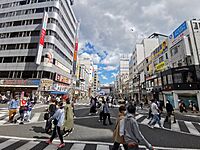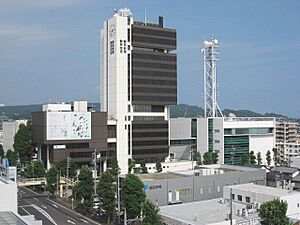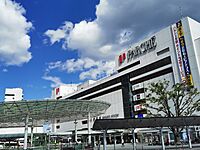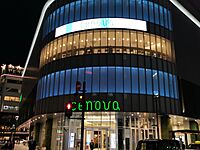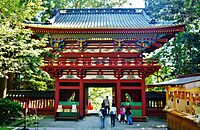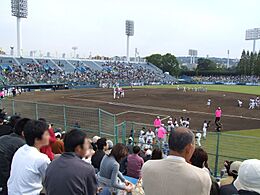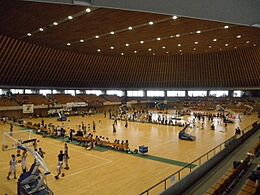Shizuoka (city) facts for kids
Quick facts for kids
Shizuoka
静岡市
|
|||||||||
|---|---|---|---|---|---|---|---|---|---|
| City of Shizuoka | |||||||||
|
|||||||||
|
|||||||||
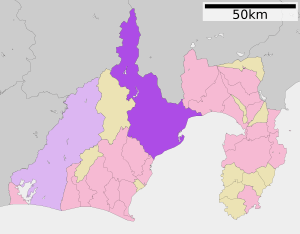
Location of Shizuoka in Shizuoka Prefecture
|
|||||||||
| Country | Japan | ||||||||
| Region | Chūbu (Tōkai) | ||||||||
| Prefecture | Shizuoka Prefecture | ||||||||
| First official record | 663 AD | ||||||||
| City Status | 1 April 1889 | ||||||||
| Area | |||||||||
| • Total | 1,411.90 km2 (545.14 sq mi) | ||||||||
| Population
(September 1, 2023)
|
|||||||||
| • Total | 677,867 | ||||||||
| • Density | 480.1098/km2 (1,243.479/sq mi) | ||||||||
| Time zone | UTC+9 (Japan Standard Time) | ||||||||
| Symbols | |||||||||
| • Tree | Flowering dogwood | ||||||||
| • Flower | Hollyhock | ||||||||
| • Bird | Common kingfisher | ||||||||
| Phone number | 054-254-2111 | ||||||||
| Address | 5-1 Ōtemachi, Aoi-ku, Shizuoka-shi, Shizuoka-ken 420-8602 | ||||||||
Shizuoka (静岡市, Shizuoka-shi, [ɕizɯꜜoka]) is a big city in Japan. It is the capital of Shizuoka Prefecture. It is also the second largest city in the prefecture by how many people live there and how big it is. People have lived here for a very long time, even before history was written down! As of September 1, 2023, about 677,867 people live in Shizuoka.
Contents
About Shizuoka City
The name "Shizuoka" comes from two Japanese words. Shizu means "still" or "calm," and oka means "hill" or "hills." So, Shizuoka means "Calm Hills."
The city was officially named Shizuoka in 1869. It became a modern city in 1885. In 2003, Shizuoka grew much bigger when it joined with the nearby city of Shimizu. For a short time, it was the largest city in Japan by land area! In 2005, Shizuoka became a "designated city." This means it has more power to make its own decisions.
City Views
- Gallery
-
Downtown Shichikenchō in 2021
Geography of Shizuoka
Shizuoka City is in the middle of Shizuoka Prefecture. It is located between Tokyo and Nagoya. To the south, it has Suruga Bay, and to the north, it has the Akaishi Mountains, also known as the Minami Alps.
The city covers about 1,411.90 square kilometers (545.14 square miles). This makes Shizuoka the 5th largest city in Japan by land area. It is also the 2nd largest city in Shizuoka Prefecture in both size and population, after Hamamatsu.
The flat areas of Shizuoka were formed over many years by the Abe River. This river carried sand and earth from the mountains, creating the land the city is built on.
Nature in Shizuoka
Shizuoka is home to many mountains, rivers, and lakes.
Mountains
- Mount Aino (間ノ岳, Aino-dake)
- Mount Shiomi (塩見岳, Shiomi-dake)
- Mount Warusawa (悪沢岳(荒川岳), Warusawa-dake (Arakawa-dake))
- Mount Akaishi (赤石岳, Akaishi-dake)
- Mount Hijiri (聖岳, Hijiri-dake)
- Mount Tekari (光岳, Tekari-dake)
- Mount Yanbushi
- Mount Daimugen
- Mankan Pass
- Mount Mafuji
- Mount Jūmai
- Mount Ryūsō
- Mount Shizuhata (賤機山, Shizuhata-yama)
- Mount Yatsu
- Mount Yahata
- Mount Udo (Nihondaira)
- Mount Kajiwara
- Mount Satta (Satta Pass)
- Mount Hamaishi
- Mount Ōmaru
- Mount Ōhira
Rivers
- Ōi River (大井川, Ōi-gawa) (upstream)
- Abe River (安倍川)
- Warashina River
- Mariko River
- Tomoe River
- Ōya River Drainage Ditch
- Nagao River
- Fuji River (富士川, Fuji-kawa)
- Okitsu River
- Ōzawa River
- Ihara River
- Yamakiri River
- Nakagōchi River
- Ōhashi River
- Kogōchi River
Lakes
- Lake Ikawa (Ikawa Dam)
- Lake Hatanagi (Hatanagi-I Dam)
- Asahata Marsh
- Kujira Pond
- Udosaka Pond
- Futatsu Pond
- Funakoshi Dike
Climate
Shizuoka has a humid subtropical climate. This means it has hot and humid summers. It rarely snows in winter. The city gets a lot of rain, but it is also one of the sunniest major cities in Japan. This is because it is protected from strong winds and summer fog. In the northern mountains, like the Ikawa area, there are even ski resorts because it gets more snow.
| Climate data for Shizuoka (1991−2020 normals, extremes 1940−present) | |||||||||||||
|---|---|---|---|---|---|---|---|---|---|---|---|---|---|
| Month | Jan | Feb | Mar | Apr | May | Jun | Jul | Aug | Sep | Oct | Nov | Dec | Year |
| Record high °C (°F) | 25.7 (78.3) |
26.2 (79.2) |
28.0 (82.4) |
33.3 (91.9) |
33.9 (93.0) |
38.3 (100.9) |
40.0 (104.0) |
38.7 (101.7) |
39.2 (102.6) |
33.9 (93.0) |
28.0 (82.4) |
24.5 (76.1) |
40.0 (104.0) |
| Mean daily maximum °C (°F) | 11.7 (53.1) |
12.6 (54.7) |
15.5 (59.9) |
19.8 (67.6) |
23.5 (74.3) |
26.1 (79.0) |
29.9 (85.8) |
31.3 (88.3) |
28.4 (83.1) |
23.6 (74.5) |
18.8 (65.8) |
14.1 (57.4) |
21.3 (70.3) |
| Daily mean °C (°F) | 6.9 (44.4) |
7.7 (45.9) |
10.7 (51.3) |
15.2 (59.4) |
19.2 (66.6) |
22.4 (72.3) |
26.1 (79.0) |
27.4 (81.3) |
24.5 (76.1) |
19.4 (66.9) |
14.3 (57.7) |
9.3 (48.7) |
16.9 (62.4) |
| Mean daily minimum °C (°F) | 2.1 (35.8) |
2.9 (37.2) |
6.0 (42.8) |
10.6 (51.1) |
15.1 (59.2) |
19.2 (66.6) |
23.1 (73.6) |
24.2 (75.6) |
21.1 (70.0) |
15.6 (60.1) |
9.9 (49.8) |
4.6 (40.3) |
12.9 (55.2) |
| Record low °C (°F) | −6.8 (19.8) |
−5.8 (21.6) |
−4.6 (23.7) |
−1.4 (29.5) |
5.1 (41.2) |
12.5 (54.5) |
15.4 (59.7) |
16.9 (62.4) |
10.6 (51.1) |
3.9 (39.0) |
−1.7 (28.9) |
−5.1 (22.8) |
−6.8 (19.8) |
| Average precipitation mm (inches) | 79.6 (3.13) |
105.3 (4.15) |
207.1 (8.15) |
222.2 (8.75) |
215.3 (8.48) |
268.9 (10.59) |
296.6 (11.68) |
186.5 (7.34) |
280.6 (11.05) |
250.3 (9.85) |
134.2 (5.28) |
80.7 (3.18) |
2,327.3 (91.63) |
| Average snowfall cm (inches) | 0 (0) |
0 (0) |
0 (0) |
0 (0) |
0 (0) |
0 (0) |
0 (0) |
0 (0) |
0 (0) |
0 (0) |
0 (0) |
0 (0) |
0 (0) |
| Average precipitation days (≥ 0.5 mm) | 5.8 | 6.5 | 10.2 | 10.5 | 10.9 | 13.6 | 12.9 | 10.6 | 12.8 | 10.9 | 7.6 | 6.1 | 118.3 |
| Average relative humidity (%) | 57 | 57 | 62 | 65 | 71 | 77 | 79 | 76 | 75 | 71 | 67 | 60 | 68 |
| Mean monthly sunshine hours | 207.9 | 187.5 | 189.9 | 189.7 | 192.0 | 135.9 | 157.9 | 201.8 | 157.3 | 157.7 | 173.3 | 200.5 | 2,151.5 |
| Source: Japan Meteorological Agency | |||||||||||||
City Wards
Shizuoka City is divided into three main parts called wards:
- ;Aoi Ward (葵区, Aoi-ku)
* This is the main administrative center of the city.
- ;Suruga Ward (駿河区, Suruga-ku)
* This ward is south of the main train line.
- ;Shimizu Ward (清水区, Shimizu-ku)
* This ward used to be the separate city of Shimizu.
Each ward has its own special color and logo!
| Aoi Ward | ■ Aoi Ward Green |
|---|---|
| Suruga Ward | ■ Suruga Ward Red |
| Shimizu Ward | ■ Shimizu Ward Blue |
Population of Shizuoka
As of August 2019, about 704,989 people lived in Shizuoka. The city has seen a small decrease in population since 1990.
| Group | Number of People | Date |
|---|---|---|
| Males | 343,339 | August 2019 |
| Females | 361,651 | |
| Households | 286,013 | |
| Foreign Residents | 9,389 | May 2019 |
| Total | 704,989 | August 2019 |
Historical Population Changes
Here's how Shizuoka's population has changed over the years:
| Historical population | ||
|---|---|---|
| Year | Pop. | ±% |
| 1940 | 395,189 | — |
| 1950 | 467,782 | +18.4% |
| 1960 | 576,482 | +23.2% |
| 1970 | 681,797 | +18.3% |
| 1980 | 727,260 | +6.7% |
| 1990 | 739,300 | +1.7% |
| 2000 | 729,980 | −1.3% |
| 2010 | 716,328 | −1.9% |
| 2020 | 693,389 | −3.2% |
Neighboring Cities and Towns
Shizuoka shares its borders with several other places:
- Minami-Alps
- Hayakawa
- Minobu
- Nanbu
- Iida
- Ina
- Ōshika
History of Shizuoka
Early History
People have lived in the Shizuoka area since very old times. The Toro archaeological site shows that a large village existed here during the Yayoi period (around 400 BC to 300 AD). This site is famous for finding old rice fields.
Later, the area became known as Suruga province. Its capital city was called Sunpu, or sometimes Fuchū.
Shizuoka in Pre-modern Times
During the Muromachi period, Sunpu was the main city for the Imagawa family. After they were defeated, famous leaders like Takeda Shingen and Tokugawa Ieyasu ruled Sunpu.
In 1606, Tokugawa Ieyasu, who was a very powerful leader, retired to Sunpu. He built a second government there and still guided Japan from behind the scenes.
From Meiji Period to World War II
In 1869, after the old government ended, Sunpu was renamed "Shizuoka." It officially became a modern city on April 1, 1889. At that time, about 37,681 people lived there. Shizuoka was one of the first 31 cities created in Japan.
Over the years, Shizuoka grew by joining with nearby towns. The city faced several challenges. In 1914, a typhoon caused the Abe River to flood the downtown area. In 1935, an earthquake caused a lot of damage. A big fire in 1940 also destroyed much of the city center.
During World War II, Shizuoka was bombed by American planes. A major bombing in June 1945 caused a lot of damage to the city.
Shizuoka After the War
After World War II, Shizuoka continued to grow. In 1964, the Tōkaidō Shinkansen (bullet train) started service to Shizuoka. In 1969, the city was connected to the Tōmei Expressway, making travel easier.
In 2003, Shizuoka merged with Shimizu City. This made Shizuoka much larger. In 2005, it became a "designated city" and was divided into three wards. More towns joined Shizuoka in 2006 and 2008, making the city even bigger.
Sister Cities
Shizuoka has special relationships with cities around the world and in Japan. These are called "sister cities" or "friendship cities." They help people from different places learn about each other's cultures.
International Sister Cities
| City | Country | State | Since |
|---|---|---|---|
| Stockton | California | October 16, 1959 | |
| Omaha | Nebraska | April 1, 1965 | |
| Shelbyville | Indiana | November 3, 1989 | |
| Cannes | Provence-Alpes-Côte d'Azur | November 5, 1991 |
International Friendship Cities
| City | Country | State | Since |
|---|---|---|---|
| Huế | Thừa Thiên Huế province | April 12, 2005 |
National Sister Cities
| City | Prefecture | Region | Since |
|---|---|---|---|
| Muroran | Hokkaidō region | December 24,1976 | |
| Jōetsu | Chūbu region | October 12, 1995 |
National Friendship Cities
| City | Prefecture | Region | Since |
|---|---|---|---|
| Saku | Chūbu region | October 12, 1989 |
Economy and Industries
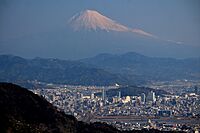
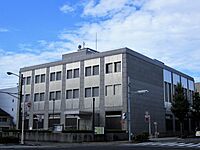
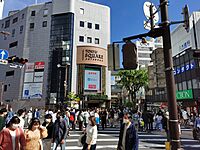
Shizuoka has many businesses. Most people work in service industries (73%), followed by manufacturing (26.9%). Only a small number work in agriculture (0.1%). The city's economy is quite strong.
Agriculture
Shizuoka is known for several farm products:
- ;Green tea: Many types of green tea are grown here. The tea from Warashina and Ryōgōchi areas is especially famous for its high quality.
- ;Strawberries: "Stonewall strawberries" are a special kind grown in holes on slanted stone walls. You can find them along "Strawberry Road."
- ;Wasabi: This spicy plant is grown in areas like Utōgi.
- ;Mandarin oranges: Especially the seedless and easy-to-peel mikan (Satsuma oranges).
- ;Lotus roots: Grown in the Asahata area.
- ;Roses: Grown in the Ihara and Okitsu areas.
- ;Peaches: Grown in the Osada area.
- ;Potatoes: Especially the Sebago potato.
Fishery
The Port of Shimizu is very important for fishing. It catches the most tuna in all of Japan! Kanbara Harbour is known for sakura ebi (small pink shrimp). Mochimune Harbour is famous for shirasu (tiny sardines).
Products
- ;Abekawa Mochi: This is a special type of rice cake. It's covered with kinako (soy flour).
- ;Model Industry: Shizuoka is famous for making plastic scale model kits. Companies like Aoshima, Fujimi, Hasegawa, and Tamiya are based here. Bandai also makes its popular Gundam models in the city. Every May, Shizuoka hosts the "Shizuoka Hobby Show," a big event for model enthusiasts.
Media
Print Media
The Shizuoka Shimbun is the main newspaper for the area.
Broadcast Media
Television
- NHK Shizuoka (Channels 1 and 2)
- Shizuoka Broadcasting System (SBS) (Channel 6)
- TV Shizuoka (Channel 8)
- Shizuoka Daiichi Television (Channel 4)
- Shizuoka Asahi Television (Channel 5)
Radio
- NHK1 (882 kHz)
- NHK2 (639 kHz)
- NHK-FM (88.8 MHz)
- SBS (1404 kHz / 93.9 MHz)
- K-MIX (79.2 MHz)
- FM-Hi!(76.9 MHz)
- Marine Pal (FM Shimizu) (76.3 MHz)
Education
Colleges and Universities
Shizuoka has several universities and colleges:
- Shizuoka University: A national university with its main campus in Suruga Ward.
- University of Shizuoka: A public university, also in Suruga Ward.
- Tokai University: Has a campus in Shimizu Ward.
- Tokoha Gakuen University: A private university.
- Shizuoka Eiwa Gakuin University: A private university that used to be a school for girls.
- University of Shizuoka Junior College: A two-year college linked to the University of Shizuoka.
- Tokai University Junior College: A two-year college linked to Tokai University.
- Tokoha Gakuen Junior College: A two-year college linked to Tokoha Gakuen University.
Schools and Libraries
The city has 91 elementary schools, 57 middle schools, and 27 high schools. There are also 29 vocational schools and 12 public libraries.
Transportation
Air Travel
The closest airport is Shizuoka Airport. It is located between Makinohara and Shimada.
Train Travel
Shizuoka is on the Tōkaidō Main Line, a major railway line connecting Tokyo and Osaka. The Tōkaidō Shinkansen (bullet train) also stops here. The main train station is Shizuoka Station.
The city also has a local train line called the Shizuoka Railway Shizuoka-Shimizu Line. This line connects different parts of the city.
High-Speed Rail
- Tōkaidō Shinkansen: - Shizuoka -
Local Train Lines
- Tōkaidō Main Line: - Shin-Kambara • Kambara • Yui • Okitsu • Shimizu • Kusanagi • Higashi-Shizuoka • Shizuoka • Abekawa • Mochimune • -
- Shizuoka Railway Shizuoka-Shimizu Line: Shin-Shizuoka – Hiyoshichō – Otowachō – Kasugachō – Yunoki – Naganuma – Furushō – Ken-Sōgō Undōjō – Kenritsu Bijutsukanmae – Kusanagi – Mikadodai – Kitsunegasaki – Sakurabashi – Irieoka – Shin-Shimizu
- Ōigawa Railway Ikawa Line: - Kanzō – Ikawa -
Roads
Expressways
 Tōmei Expressway
Tōmei Expressway Shin-Tōmei Expressway
Shin-Tōmei Expressway Chūbu-Ōdan Expressway
Chūbu-Ōdan Expressway
National Routes
 National Route 1
National Route 1 National Route 52
National Route 52 National Route 149
National Route 149 National Route 150
National Route 150 National Route 362
National Route 362
Sea Travel
The Port of Shimizu is a busy seaport. It handles large container ships, cargo ships, and cruise ships. It's located between the major port areas of Tokyo and Osaka. The port is important for both imports and exports. It also has a terminal for receiving natural gas.
Tourism and Attractions
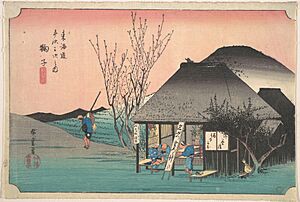
Shizuoka has many interesting places to visit, from museums to historic sites.
Museums
- Shizuoka Prefectural Museum of Art
- Shizuoka City Tokaido Hiroshige Museum of Art
- Museum of Natural and Environmental History, Shizuoka
Major Attractions
- Nihondaira: A scenic area with great views.
- Miho no Matsubara: A beautiful pine grove along the coast.
Historic Spots
In Aoi Ward
- ;Shizuoka Sengen Shrine: A group of shrines that were important to powerful families like the Tokugawa clan.
- ;Sunpu Park/Sunpu Castle ruins: This was once a castle belonging to the Imagawa and Tokugawa families. The castle was destroyed, and now only the moats remain. It's a popular park, especially for viewing cherry blossoms.
In Suruga Ward
- ;Toro: An ancient archaeological site from the Yayoi period. It's famous for showing how people grew wet rice over 1,700 years ago.
- ;Kunōzan Tōshō-gū: A Shinto shrine where the famous leader Tokugawa Ieyasu was first buried. It's the oldest Tōshō-gū shrine in Japan.
- ;Mariko-juku: This was the twentieth stop on the old Tōkaidō road. This road was used for travel during the Edo period.
In Shimizu Ward
- ;Miho Peninsula: Famous for the beautiful Miho no Matsubara (三保の松原, Miho Pine Grove). It has lovely green pine trees and white sands along seven kilometers of coastline. It's also known for the legend of Hagoromo, a story about a swan maiden.
Culture
Festivals
- ;Daidogei World Cup (大道芸ワールドカップ, Daigougei Waarudo kappu): This is a big international festival for street performers. It happens every November in different parts of the city.
- ;Shizuoka Festival (静岡まつり, Shizuoka Matsuri): This festival takes place in April, when cherry blossoms are at their best. It includes a parade that remembers when Tokugawa Ieyasu went to Sengen Shrine to see the cherry blossoms.
- ;Abekawa Fireworks (安倍川花火, Abekawa Hanabi): A huge fireworks show held in late July over the Abekawa River. It started in 1953 to remember those who passed away during World War II. Today, about 15,000 fireworks light up the sky.
Cuisine
Shizuoka has some unique foods:
- ;Oden: This is a Japanese stew with ingredients like boiled eggs and fish cakes. Shizuoka's oden has a dark broth made with beef stock and dark soy sauce. All the ingredients are on skewers. People often sprinkle dried fish powder and seaweed on top.
- ;Gyoza
- ;Soba noodles
- ;Seafood
- ;Zōni soup: Rice cakes in a vegetable broth, popular during New Year.
- ;Tororo-jiru: A soup made from grated yam. There's a very old restaurant called Chojiya in Mariko-juku that has served this soup since 1598!
Shizuoka Performing Arts Center
The Shizuoka Performing Arts Center (SPAC) was created in 1995. It has its own group of actors and staff. They manage venues and create theater shows. SPAC hosts the World Theatre Festival Shizuoka every year. This festival brings plays, puppetry, dance, and other performances from all over the world. In 2020, the festival was held online due to the COVID-19 pandemic.
Sports
Shizuoka is home to several sports teams. The main football club is Shimizu S-Pulse. There are also basketball, softball, table tennis, and baseball teams.
| Club | Sport | League | Venue | Established |
|---|---|---|---|---|
| Chanson V-Magic | Basketball | W.League | Konohana Arena | 1961 |
| Seikō | Softball | Japan Softball League(JSL) | Kusanagi Stadium | 1980 |
| Shimizu S-Pulse | Football | J.League | IAI Stadium Nihondaira | 1991 |
| Veltex Shizuoka | Basketball | B.League | Shizuoka City Central Gymnasium | 2018 |
| Shizuoka Jade | Table tennis | T.League | Shizuoka City Central Gymnasium | 2022 |
| Kufu HAYATE Ventures Shizuoka | Baseball | NPB (Western League) | Shizuoka City Shimizu Ihara Stadium | 2024 |
Notable People from Shizuoka
Many famous people come from Shizuoka, including:
- Princess Akishino – A princess in the Japanese Imperial Family.
- Yoshitaka Amano – An illustrator who designed characters for the Final Fantasy video games.
- Kenta Hasegawa – A professional football manager and former player.
- Kazuyoshi Hoshino – A racecar driver.
- Hidetaka Miyazaki – A video game director, creator of the Dark Souls series.
- Kazuyoshi Miura – A professional football player.
- Riyo Mori – Miss Universe Japan 2007 and Miss Universe 2007.
- Momoko Sakura – A cartoonist who created Chibi Maruko-chan.
- Masatoshi Shima – An inventor of the microprocessor.
- Yoshito Usui – The creator of the Crayon Shin-chan comics.
- Kiyoe Yoshioka – A singer, the lead vocalist of Ikimono-gakari.
City Song
Shizuoka has its own city song called Watashi no Machi, Shizuoka (わたしの街 静岡), which means "My Town, Shizuoka." The lyrics were chosen from a citizen competition.
See also
 In Spanish: Shizuoka para niños
In Spanish: Shizuoka para niños


